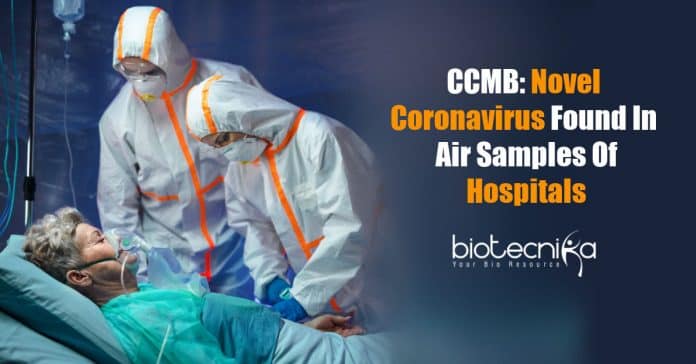CCMB study reveals the presence of novel coronavirus in air samples
A study carried out by the Centre for Cellular, and Molecular Biology (CCMB) revealed the possibility of airborne transmission of the novel coronavirus under certain conditions. The study was performed to ascertain the virus’s transmission pattern in different units in hospitals to evaluate the dangers posed to health care staff. Air samples collected from hospitals in Hyderabad and Mohali were used for the study.
Initially, the SARS-CoV-2 was thought to be spreading mostly by contact and droplets. Therefore, hand washing, using masks, and social distancing were the essential measures recommended to prevent disease spread. A constant rise in the number of COVID-19 cases revealed the chance for airborne transmission, which is distinct from droplet transmission. Aerosol particles stay suspended in the air for a longer duration, as they are smaller in dimension than droplets. This makes airborne transmission much more transmittable.
Officials from CCMB stated that currently, scientists could detect the virus in infectious aerosols of the size of less than 5μm. The smaller sized aerosols might get developed due to the vaporization of water from bigger respiratory droplets. The smaller-sized aerosols remain in the air for a longer
period as well as travel longer distances. Therefore the enigma emerges whether the 1 or 2 meters distance is safe or not. There is some arising proof that shows the possibility of air-borne transmission of COVID-19.Presently, various nations have unwinded the constraints on mobility and interactions making the suggested safety measures hard to implement in public setups. The authors of the study stated that – according to the evidence acquired from the study, the observations of the research considerately reassure individuals that advocated preventive measures would mainly succeed in avoiding the infection and advise the governments to proceed to promote the same.
The study group isolated 64 air samples from various setups, from rooms that were occupied and unoccupied by COVID-19 positive individuals. The virus was identified in air samples isolated from COVID19 wards but not in other wards. Therefore, the study shows that the presently used technique of separating the healthcare facilities into COVID and non-COVID wards works are useful and necessary. Even more, the outcomes of the research reveal that the long term presence of COVID-19 positive people causes a boosted aerosol load in the air.
The research finds that a small duration of exposure to COVID-19 positive people may not place one at high risk. The outcomes of the study show that the probability of encountering novel coronavirus in the air is undeviatingly linked to many COVID positive instances in the room, their symptomatic condition and the span of exposure and that of the division of medical facilities into COVID and non-COVID areas is a successful method to contain cross infections.
Additionally, CCMB has provided an advisory to contain the COVID-19 transmission. The advisory recommends using masks and keeping a social distance of a minimum of 3 ft. Also, it recommends carrying out functions in well-ventilated open areas, as the SARS-CoV-2 remains much longer in enclosed places. Additionally, it has stressed practicing caution in public toilets.
The advisory stated that flushing has the possibility to create aerosols that can stay much longer in the air, and the virus is understood to be discharged in the stool. Masks should always be used while using the bathrooms, and if possible, the same toilet must be reused only after half an hour or more. Illustrated directions need to be stuck in the toilets concerning cleaning them after use. This must be complied with by appropriate hand sanitation.
CCMB study reveals the presence of novel coronavirus in air samples






























